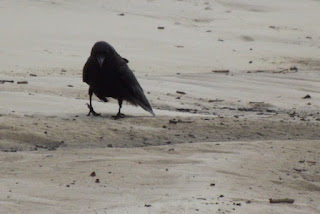It has been a hectic and strange summer, as well as a hot one. I've been getting out whenever I can, and, fortunately, there are always plenty of interesting birds and other wildlife to see. Here are some sightings from the last few months!
Sanderlings generally depart from their wintering grounds for the Arctic by the end of
spring, and that was technically still the season when I saw this bird foraging
along the shore. If you compare the
plumage of this bird to Sanderlings in some of my other posts, you’ll see how
much richer and redder it is: breeding plumage.
 |
| Sanderling |
Ruddy Turnstones easily beat it in flashiness, though: caramel brown, black, and white. A palette like turtle ice cream, maybe, but it stands out against the beige and gray of the sand and mud.
 |
| Ruddy Turnstone |
A lone Reddish Egret has a fierce appearance, which befits its predatory nature. Imagine being a fish and that yellow eye being one of the last things you see before going down the egret's gullet!
 |
| Reddish Egret |
Although far from rare, the Gull-billed Tern is generally one of the less commonly seen resident tern species around here. It has a distinctively thick, black bill and narrow, pale wings. This one went through an entire preening session as I watched it.
 |
| Gull-billed Tern |
Avian migration seems never to end on the coast, and it could be argued that it truly doesn't. Even in late June, the middle of summer for the Southeast, it's not uncommon to find migratory shorebirds, such as the boldy patterned American Avocets. These three individuals appeared to be striking poses against the waves as the sun set that evening.
 |
| American Avocets |
Of course, beaches attract more than just seashore species. Eurasian Collared-Doves drop down on occasion to scavenge what they can from the sand and debris.
 |
| Eurasian Collared-Doves |
Fish Crows are far better adapted to wetland habitats than the Collared-Doves are, so it's less of a surprise to see them walking there. This individual crow examined the seashore debris closely and methodically before flying back in the direction of the city.
 |
| Fish Crow |
Away from the shore, in the brackish bayous and marshes, a different species community exists. This is where I sometimes hear and see secretive Clapper Rails. This one had temporarily left the dense cover of the marsh grasses to wade in the shallows in a small clearing.
 |
| Clapper Rail |
The usual wariness of these birds (and many other animals in the area) makes sense when you consider the predators that they need to evade in order to eke out a living in their marshy home. This means that the alligators, too, have to operate through stealth. When summer is over and late autumn's cooler weather eventually rolls in (if it ever does), these gators may become dormant, emerging only on warmer days.
 |
| American alligator |
Regardless of the weather, it's a joy to be out in nature. Hopefully, the conditions will improve a bit as we transition into August.





what fun birding that must be
ReplyDelete